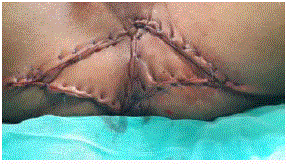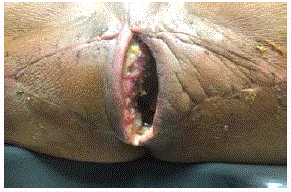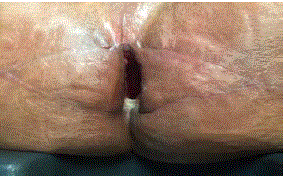Case Report
Unsuccessfull Perineal Reconstruction with Myocutaneous V-Y Advancement Flap after Extralevator Abdominoperineal Excision for Low Rectal Cancer
Gurel Nessar¹*, Ahmet Nurettin Cengiz¹, Hasan Cem Misirlioglu² and Ali Eba Demirbag¹
¹Department of Gastroenterology Surgery, Yuksek Ihtisas Hospital, Turkey
²Department of Radiation Oncology, Ankara Oncology Hospital, Turkey
*Corresponding author: Gurel Nessar, Department of Gastroenterology Surgery, Yuksek Ihtisas Hospital, Muhsin Yazicioglu Caddesi 52/7, Cankaya, Ankara, Turkey
Published: 30 Nov, 2017
Cite this article as: Nessar G, Cengiz AN, Misirlioglu HC,
Demirbag AE. Unsuccessfull Perineal
Reconstruction with Myocutaneous V-Y
Advancement Flap after Extralevator
Abdominoperineal Excision for Low
Rectal Cancer. Clin Surg. 2017; 2:
1780.
Abstract
Extralevator abdominoperineal excision of the rectum was introduced with the aim of improving the
oncological outcome of low rectal cancer. The technique includes resection of the levator muscles
from their origins on the pelvic side walls and their en bloc removal along with the mesorectum,
which results in a larger perineal defect than is seen after conventional surgery. For reconstruction
of large perineal defects, pedicled muscle flaps are recommended but the procedure is technically
challenging and plastic surgery consultation is necessary. Local flap techniques such as a gluteus
maximus myocutaneous V-Y advancement flap are an easier option. In this case report, wound
failure following a local flap repair of a perineal defect is presented.
Keywords: Rectal cancer; Extralevator abdominoperineal excision; Gluteus maximus
myocutaneous V-Y advancement flap
Introduction
Wide excision of perineal lesions, often including excision of the anal canal or rectum, may be necessary for the treatment of a number of benign and malignant conditions. Extralevator Abdominoperineal Excision (ELAPE) of the rectum was introduced with the aim of improving the oncological outcome of low rectal cancer. The technique includes resection of the levator muscles from their origins on the pelvic side walls and their en bloc removal along with the mesorectum. Closure of the large resulting defect is technically challenging, especially when the patient has also received neoadjuvant radiotherapy. Pedicled muscle flaps seem to be the treatment of choice for covering perineal defects, but this necessiates plastic surgery consultation. Local flap techniques such as gluteus maximus V-Y advacement flap are easier to perform. We report our first experience with local flap closure of a large perineal defect after ELAPE following chemoradiotherapy of rectal cancer. Unfortunately, local flap coverage of the perineal defect was not succesfull.
Case Presentation
A 54-year-old man was diagnosed with rectal adenocarcinoma in December 2014. The tumor was located at the lower part of the rectum and was associated with an anal fistula. Digital rectal examination, plain chest radiography, colonoscopy, and computerized tomography were used for evaluation of the patient. The tumor stage was cT4N+, and the patient was administered long-term chemoradiotherapy (5-fluorouracil, 5040 cGy). Restaging after 8 weeks of neoadjuvant therapy showed tumor downsizing but no downstaging. Abdominoperineal excision and para-aortic lymhadenectomy was performed by a consultant surgeon who had undergone training in the use of the extralevator technique. The perineal wound defect was closed with a gluteus maximus myocutaneous V-Y advancement flap (Figure 1). The operation time was 480 mins and the estimated blood loss was 400 mL. Urinary incontinence developed postoperatively and the patient required an indwelling catheter for 6 weeks. Unfortunately, perineal wound dehiscence occured on the tenth postoperative day (Figure 2). Open wound treatment was applied, and the patient was discharged 15 days after the surgery. Intensive wound care including hyperbaric oxygen therapy was applied for the next 12 months; however, the perineal wound healing is not complete even 2 years after the surgery (Figure 3). Informed consent was obtained for the operation presented in the study.
Figure 1
Figure 2
Figure3
Discussion
Perineal wound complications after abdominoperineal excision
are frequent and have an impact on the length of hospitalization,
quality of life, and oncologic results [1,2]. Perineal morbidity occurs
significantly more frequently in ELAPE patients [3,4]. Radiotherapy
and longer operation times may also be contributing factors for
perineal morbidity in these groups of patients. Closure of large defects
is technically challenging, especially when neoadjuvant radiotherapy
has also been given. Pelvic floor reconstruction using various
techniques has been advocated to decrease perineal morbidity. Local
flap reconstruction is a useful technique for the repair of perineal
defects without much effort [5,6]. We used a bilateral gluteus maximus
myocutaneous V-Y advancement flap for closure of the pelvic floor
defect after ELAPE. However, the result of the operation was not
succesfull and this would be related to irradiation of the pelvic floor.
Radiotherapy may cause the development of chronic inflammation
and fibrosis, significantly impairing wound repair. Moreover, local
flap surgery was our first experience which might also contributing
factor to the wound failure.
Pedicled muscle flap seems to be method of choice for
reconstruction as they introduce vascularized tissue into a radiated
field [7]. The Vertical Rectus Abdominis Myocutaneous (VRAM)
flap has been used successfully to cover perineal defects [8,9]. A free
latissimus dorsi myocutaneous flap is an option when the VRAM flap
cannot be used because of the need for placement of bilateral stomas
[10]. However, all of these techniques are time consuming and
require plastic surgery consultation. Biological mesh repair has been
attempted but the rates of perineal wound complications or perineal
hernia formation were comparable with that with primary wound
closure [11]. Porcine collagen treatment may be an attractive option
in centers where plastic surgery specialists are not available [12].
References
- Bullard KM, Trudel JL, Baxter NN, Rothenberger DA. Primary perineal wound closure after preoperative radiotherapy and abdominoperineal resection has a high incidence of wound failure. Dis Colon Rectum. 2005;48(3):438-43.
- Hawkins AT, Berger DL, Shellito PC, Sylla P, Bordeianou L. Wound dehiscence after abdominoperineal resection for low rectal cancer is associated with decreased survival. Dis Colon Rectum. 2014;57(2):143-50.
- Nessar G, Demirbag AE, Celep B, Elbir OH, Kayaalp C. Extralevator abdominoperineal resection compared with standard surgery: single surgeon experience. Ulus Cerrahi Derg. 2016;32(4):244-7.
- Welsch T, Mategakis V, Contin P, Kulu Y, Büchler MW, Ulrich A. Results of extralevator abdominoperineal resection for low rectal cancer including quality of life and long-term wound complications. Int J Colorectal Dis. 2013;28(4):503-10.
- Orkin BA. Perineal reconstruction with local flaps: technique and results. Tech Coloproctol. 2013;17(6):663-70.
- Anderin C, Martling A, Lagergren J, Liung A, Holm T. Short-term outcome after gluteus maximus myocutaneous flap reconstruction of the pelvic floor following extra-levator abdominoperineal excision of the rectum. Colorectal Dis. 2012;14(9):1060-4.
- Sheckter CC, Shakir A, Vo H, Tsai J, Nazerali R, Lee GK. Reconstruction following abdominoperineal resection (APR): Indications and complications from a single instituion experience. J Plast Reconstr Aesthet Surg. 2016;69(11):1506-12.
- Horch RE, Hohenberger W, Eweida A, Kneser U, Weber K, Arkudas A, et al. A hundred patients with vertical rectus abdominis myocutaneous (VRAM) flap for pelvic reconstruction after total pelvic exenteration. Int J Colorectal Dis. 2014;29(7):813-23.
- Barker T, Branagan G, Wright E, Crick A, McGuiness C, Chave H. Vertical rectus abdominis myocutaneous flap reconstruction of the perineal defect after abdominoperineal excision is associated with low morbidity. Colorectal Dis. 2013;15(9):1177-83.
- Abdou AH, Li L, Khatib-Chahidi K, Troia A, Looft P, Gudewer EM, et al. Free latissimus dorsi myocutaneous flap for pelvic floor reconstruction following pelvic exenteration. Int J Colorectal Dis. 2016;31(2):385-91.
- Musters GD, Bemelman WA, Bosker RJ, Burger JW, van Duijvendijk P, van Etten B, et al. Randomized controlled multicentre study comparing biological mesh closure of the pelvic floor with primary perineal wound closure after extralevator abdominoperineal resection for rectal cancer (BIOPEX-study). BMC Surg. 2014;27:14-58.
- Harries RL, Luhmann A, Harris DA, Shami JA, Appleton BN. Prone extralevator abdominoperineal excision of the rectum with porcine collagen perineal reconstruction (Permacol™): high primary perineal wound healing rates. Int J Colorectal Dis. 2014;29(9):1125-30.



